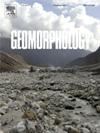New insights into the timing of the Yellow River flowing into the North China Plain: Evidence from detrital zircon UPb geochronology and heavy mineral assemblages of sediments
IF 3.1
2区 地球科学
Q2 GEOGRAPHY, PHYSICAL
引用次数: 0
Abstract
Identifying the timing of the Yellow River flowing into the North China Plain (also referred to as the integration of the middle and lower reaches of the Yellow River or the integration of the Yellow River) is essential for understanding the evolutionary processes of the Yellow River and the North China Plain, as well as the interplay between tectonic deformations and climatic change in this region. This study investigated sediments from borehole S005, drilled in the Yellow River alluvial fan within the Kaifeng sag, Henan Province, using detailed magnetostratigraphic analysis, detrital zircon U![]() Pb geochronology, and heavy mineral assemblage analysis. The magnetostratigraphic and optically stimulated luminescence results reveal that sediments in borehole S005 span about 3.33 Ma. Of these sediments, those deposited after about 1.32 Ma exhibit similar detrital zircon U
Pb geochronology, and heavy mineral assemblage analysis. The magnetostratigraphic and optically stimulated luminescence results reveal that sediments in borehole S005 span about 3.33 Ma. Of these sediments, those deposited after about 1.32 Ma exhibit similar detrital zircon U![]() Pb age spectra and heavy mineral assemblages to the sediments in the middle and upper reaches of the Yellow River, suggesting that the Yellow River has cut through the Sanmen Gorge and supplied sediments to the North China Plain since about 1.32 Ma. This study excludes the far-field effect of the Late Pliocene uplift of the northeastern Qinghai-Tibet Plateau on the integration of the Yellow River. Additionally, this study proposes that the integration of the Yellow River was triggered by the fluvial incision and headwater erosion associated with the drastic climatic change during the Pleistocene.
Pb age spectra and heavy mineral assemblages to the sediments in the middle and upper reaches of the Yellow River, suggesting that the Yellow River has cut through the Sanmen Gorge and supplied sediments to the North China Plain since about 1.32 Ma. This study excludes the far-field effect of the Late Pliocene uplift of the northeastern Qinghai-Tibet Plateau on the integration of the Yellow River. Additionally, this study proposes that the integration of the Yellow River was triggered by the fluvial incision and headwater erosion associated with the drastic climatic change during the Pleistocene.
求助全文
约1分钟内获得全文
求助全文
来源期刊

Geomorphology
地学-地球科学综合
CiteScore
8.00
自引率
10.30%
发文量
309
审稿时长
3.4 months
期刊介绍:
Our journal''s scope includes geomorphic themes of: tectonics and regional structure; glacial processes and landforms; fluvial sequences, Quaternary environmental change and dating; fluvial processes and landforms; mass movement, slopes and periglacial processes; hillslopes and soil erosion; weathering, karst and soils; aeolian processes and landforms, coastal dunes and arid environments; coastal and marine processes, estuaries and lakes; modelling, theoretical and quantitative geomorphology; DEM, GIS and remote sensing methods and applications; hazards, applied and planetary geomorphology; and volcanics.
 求助内容:
求助内容: 应助结果提醒方式:
应助结果提醒方式:


